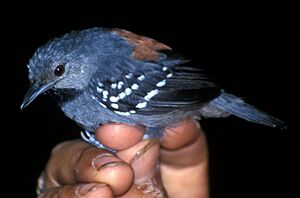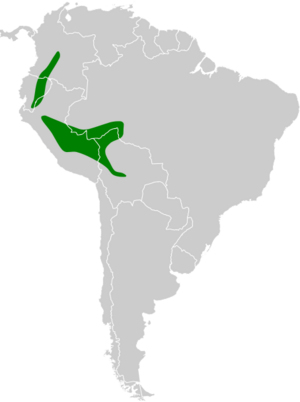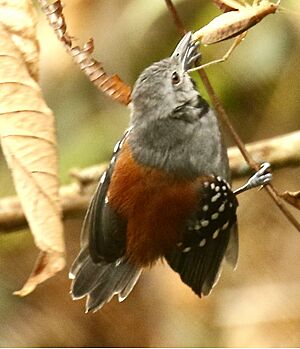Ornate stipplethroat facts for kids
Quick facts for kids Ornate stipplethroat |
|
|---|---|
 |
|
| Male from Cordillera del Cóndor, Ecuador | |
| Conservation status | |
| Scientific classification | |
| Genus: |
Epinecrophylla
|
| Species: |
ornata
|
| Subspecies | |
|
See text |
|
 |
|
The ornate stipplethroat (Epinecrophylla ornata) is a small, colorful bird found in the forests of South America. It lives in countries like Bolivia, Brazil, Colombia, Ecuador, and Peru. This bird was once called the "ornate antwren." It's known for its unique calls and how it finds its food.
Contents
Understanding the Ornate Stipplethroat
How Scientists Name Birds
The ornate stipplethroat was first described by a scientist named Philip Sclater in 1853. He gave it the scientific name Formicivora ornata. Later, it was moved to a different group of birds called Myrmotherula.
In 2006, scientists used new studies to create a new group, or genus, called Epinecrophylla. The ornate stipplethroat and seven other birds were moved into this new group. They are now all called "stipplethroats" because of a special feature on their throats. This helps tell them apart from other "antwrens."
Different Types of Ornate Stipplethroats
Most bird experts agree that there are five different types, or subspecies, of the ornate stipplethroat. These are:
- E. o. ornata
- E. o. saturata
- E. o. atrogularis
- E. o. meridionalis
- E. o. hoffmannsi
However, some groups, like BirdLife International, think that E. o. hoffmannsi is actually its own separate species. They call it the "eastern ornate stipplethroat." They then call the other four subspecies the "western ornate stipplethroat." For this article, we will follow the idea that there is one species with five subspecies.
What Ornate Stipplethroats Look Like
The ornate stipplethroat is a small bird, about 9 to 11 centimeters (3.5 to 4.3 inches) long. It weighs about 8.5 to 11 grams (0.3 to 0.4 ounces).
Male and Female Differences
Male ornate stipplethroats of the most common type (E. o. ornata) have a gray head, neck, and upper back. Their lower back and rump are a reddish-brown color. Their tail is dark gray with thin white edges. Their wings are dark gray with white tips. They have a solid black throat. Their belly is mostly light gray.
Female ornate stipplethroats of this type have a face that is mostly brownish-orange. Their head, neck, and upper back are grayish-brown. Their throat is black with white stripes. Their belly is brownish-orange, darker on the sides.
Subspecies Variations
- Males of E. o. saturata are darker and richer in color than the common type. Females are also a bit darker.
- Males of E. o. atrogularis are similar to saturata males. Females have grayer upper parts and no brownish-orange on their belly.
- Males of E. o. meridionalis have completely gray upper parts (no reddish-brown). Their belly is light gray. Females have gray to grayish-brown upper parts and a brownish-orange belly.
- Males of E. o. hoffmannsi have less reddish-brown on their upper parts than the common type. Females have the same brownish-orange throat as their belly. They also have less reddish-brown on their upper parts, and their wings have buff spots instead of white ones.
Where Ornate Stipplethroats Live
The different types of ornate stipplethroats live in specific areas:
- E. o. ornata: Found in Meta Department, Colombia.
- E. o. saturata: Lives in south-central Colombia, eastern Ecuador, and northeastern Peru.
- E. o. atrogularis: Found in east-central Peru and western Brazil.
- E. o. meridionalis: Lives in southeastern Peru, northwestern Bolivia, and nearby western Brazil.
- E. o. hoffmannsi: Found in the Amazon region of Brazil.
Their Forest Homes
Ornate stipplethroats mostly live in evergreen forests. This includes forests on high ground (terra firme), forests that are changing, and forests that flood (várzea). In some places, they like areas with lots of Guadua bamboo. In other places, they prefer areas with many tangled vines.
They can be found at different heights depending on the country. In Colombia, they live up to 1,500 meters (4,900 feet) high. In Brazil, they are found up to 900 meters (3,000 feet). In Ecuador, they live up to 1,200 meters (3,900 feet) high.
Ornate Stipplethroat Behavior
Movement and Home
Scientists believe that the ornate stipplethroat stays in the same area all year round. It does not migrate.
What They Eat
The ornate stipplethroat eats arthropods, which are creatures like insects and spiders. They usually look for food alone, in pairs, or in small family groups. Often, they join mixed-species feeding flocks, which are groups of different bird species feeding together.
They mostly search for food in the middle and lower parts of the forest, about 4 to 9 meters (13 to 30 feet) above the ground. Sometimes they go as low as 1 meter (3 feet) or as high as 20 meters (66 feet). They find their prey by picking it off dead leaves on trees, or from dead leaves caught in vines and small palm trees.
Reproduction and Nests
Scientists are still learning about the ornate stipplethroat's breeding season. In lowland Ecuador, it seems to be from December to July. In Peru, it includes July.
One nest of the E. o. hoffmannsi subspecies was an open cup made of thin roots, dry leaves, and twigs. It was hanging in a tree branch fork. Another nest, from E. o. atrogularis, was shaped like a dome with an entrance on the side. It was made of dead leaves, small roots, and moss. This dome-shaped nest held two eggs. We don't know how long the eggs take to hatch or how long the young birds stay in the nest. We also don't know much about how the parents care for their young.
Their Calls and Songs
The song of the ornate stipplethroat changes depending on the subspecies.
- The song of E. o. saturata is a thin, high-pitched chipping sound that fades away, like "tsee-tsee-tsi-tsi-tsitsitsi."
- The song of E. o. hoffmannsi is a very high, thin, rattling trill that drops in pitch at the end.
- The songs of meridionalis and atrogularis are similar to hoffmannsi but don't drop in pitch as much at the end.
The calls of the species are more similar across all types. They are described as a short, strong "pseet!" or "tsee!". The E. o. hoffmannsi subspecies also makes a "grating 'zee-zee-zee-' " sound.
Status of the Ornate Stipplethroat
The IUCN (International Union for Conservation of Nature) studies how many animals are left in the wild. They look at the "western" and "eastern" ornate stipplethroats separately. Both types live in very large areas. Scientists don't know exactly how many there are, but they believe the population is stable. This means the number of birds is not going down.
No immediate dangers have been found for either type of ornate stipplethroat. The bird is considered fairly common in most places it lives, but it can be hard to find in Ecuador and uncommon in Colombia. It lives in several large protected areas. Also, huge areas of untouched forest where these birds live seem to be safe from development for now, even if they are not officially protected.



